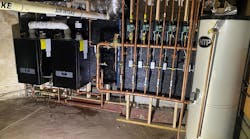Latest from Hydronics
Sponsored
Any sports expert will tell you teamwork is the most important aspect in establishing long-term success for a franchise. The best organizations have individual parts but work together as a cohesive unit that hopefully leads to a championship.
Heating units won’t be hanging any championship banners, but through a process called cascading, separate units work as a single unit to provide the most efficient method of heating large homes and commercial properties.
Earlier this year, workers installed two Ariston HTP ELU 199K BTU boilers in a 4,000 square foot Massachusetts home that uses a cascading system to meet the heating demand for the five-bed, six-bath structure. The house, built in 1889 on the North Shore just 15 minutes from Boston, needed new boilers after two 250K boilers reached the end of their service life. In a coastal community in an often-frigid state, the heat demand for this particular home is indeed intense.
Working with Emerson Swan, the team at Jeff Potvin Plumbing & Heating installed a solution that uses cascading as an efficient heating source for the house. Remarkably, the boilers are located next to the homeowner’s living room but noise from the mechanical units do not infiltrate the living space. “The homeowner was amazed at how quiet they were,’’ Potvin said. “Even in the mechanical room where they were installed.”
Team Approach
Whether cascading is even an option comes down to BTU heat load calculation. A bigger structure will generate more heat demand.
Say a building has a 10 million BTU heat load calculation. An Ariston HTP Elite Ultra XL boiler provides 2 million BTUs and would require five of them to satisfy the heating capacity of the building when 100 percent of the load is demanded.
Most of the time, however, 100 percent of the load is not required, and less heat is needed in short term duration. A zone might come on in the system that calls for 2 million BTUs. With cascading, all five boilers act as one to meet the demand. If the building needs 100 percent of the heat, all five units would activate.
One unit orchestrates the activities of an entire group. HTP calls it a Master and Follower installation. Follower heaters are controlled by the master unit—in the sports vernacular, the captain—and dictates when all units operate. Most cascade systems have lead/lag rotation grouping to spread the demand load evenly so that no one unit is used more than the others.
Beneficial Redundancy
The benefit to cascading is redundancy, which ensures that a building or home retains availability to hot water in the event of a failure.
For example, a building uses five boilers to produce 10 million BTUs of hot water. After two years, the first boiler is taken out of operation for maintenance. With the cascade design, the building can manage day to day activities to keep hot water available to the entire building with just four boilers.
Even in unplanned downtime, cascading allows the system to keep hot water flowing to all who need it. If a unit fails due to an error code, the other units in a cascade system meet the demand. If a business has just one boiler for daily operations, and it fails or needs maintenance, the business must close. Restaurants, hospitality and service industries can’t afford downtime.
Cascading also spreads the load across multiple units, so that all boilers are actively supporting each call. HTP’s Elite Series has programming that shifts loads of a heat call when the first unit gets to 80 percent operation. Once a boiler hits that mark, it will split, and another unit will fire to divvy up the demand call.
Some units even include rotation clocks. Elite Ultra models can be programmed for specific hours of operation. For example, one boiler can be programmed for six hours. When that time expires, the next boiler in the rotation picks up the next 6-hour shift. By ensuring that all units are used equally, the system needs less maintenance and individual components will last far longer.
Commercial and Residential
Cascading systems are used mostly in commercial applications. Hotels, hospitals and office buildings have high demand, so cascading systems give them an efficient and reliable option to meet that demand.
As the home in Massachusetts reveals, however, cascading systems can also be installed in residences. In most cases, larger homes might benefit from a cascading system. One of the concerns with boilers is noise, especially as their heat output increases
“One of the things that I like about the Elite Ultra is it’s the easiest to control,’’ said Joe Savignano of Emerson Swan, who recommended the system for the Massachusetts homeowner. “The Wi-Fi function enables remote monitoring of the system. It’s also a very quiet system. Ariston made these for European homes and are made to be super quiet. Even with a 3-way valve moving, you don’t hear a thing.”
Another residential application might be for a home that includes a snowmelt system for the driveway. The heat load for the home could be 130,000 BTUs for the house and 250,000 BTUs for the driveway. The solution could be individual systems, or two Elite Ultra-199WBN models to cover the total heat load.
One more application demonstrates the benefit of a cascading system. An apartment complex in Derry, N.H. installed three Elite Ultra boilers in a tight footprint for an apartment complex. By using multiple units, installers have greater flexibility in irregular spaces. The mechanical room for the apartments had limited space, so a cascading system proved to be a good solution.
Whether it’s sports, business or even a marriage, good teamwork is always a winning and durable combination. With cascading, it turns out the same can be said about heating solutions.
Thomas Renner writes on architecture, building, construction and other trade industry topics for publications throughout the United States.



